Corinne Griffith
Corinne Griffith (née Griffin; November 21, 1894 – July 13, 1979) was an American film actress, producer, author and businesswoman. Dubbed "The Orchid Lady of the Screen,"[3] she was widely regarded as one of the most beautiful actresses of the silent film era. In addition to her beauty, Griffith achieved critical recognition for her performance in Frank Lloyd's The Divine Lady (1929), which earned her a nomination for the Academy Award for Best Actress.
Corinne Griffith | |
|---|---|
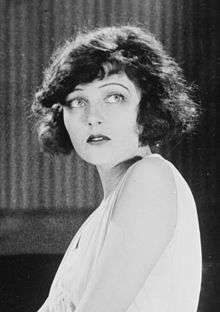 | |
| Born | Corinne Griffin November 21, 1894 Waco, Texas, U.S. |
| Died | July 13, 1979 (aged 84) Santa Monica, California, U.S. |
| Nationality | American |
| Alma mater | University of Texas at Austin |
| Occupation |
|
| Years active | 1916–1932; 1962 |
| Net worth | $150 million (1979)[1][2] |
| Spouse(s) | Danny Scholl
( m. 1965; div. 1965) |
| Children | 2, adopted |
| Signature | |
Originally from Texas, Griffith pursued a film career after winning a beauty contest in Southern California. In 1916, she signed a contract with Vitagraph Studios, appearing in numerous films for the studio through the remainder of the decade. In 1920, she began making films for First National Pictures, and became one of the studio's bigger stars. In the mid-1920s, she began executive-producing features, and served as a producer on 1925's Déclassée and Classified, in both of which she starred.
In the latter part of the 1920s, Griffith's film career slowed, though she had lead performances in Outcast (1928) and the drama The Garden of Eden (also 1928). The following year, she was nominated for the Academy Award for Best Actress for her performance in The Divine Lady. She starred in Lilies of the Field, a remake of the 1924 film in which she had also starred. Her following film, Back Pay (1930), was promoted as Griffith's final screen appearance before her retirement. She did, however, appear as the lead in Lily Christine, her first sound film, two years later.
After 1932, Griffith retired from acting and became a successful author and businesswoman, writing numerous fiction and non-fiction books, as well as venturing into real estate, in which she had begun investing in the 1920s. She married her third husband, Washington Redskins owner George Preston Marshall, in 1936, and remained married to him until 1958. She made her final film appearance with a minor role in Paradise Alley (1962), which marked her first screen appearance in 28 years. A biographical film about Griffith's life was released in 1963 titled Papa's Delicate Condition, based on her 1952 memoir and focusing on the relationship between her and her father. After suffering a stroke in July 1979, Griffith was hospitalized in Santa Monica, California, where she died shortly after of a heart attack. She left behind a reported estate of $150 million, making her one of the wealthier women in the world at that time.[2]
Biography
1894–1932: Early life and Vitagraph films
Griffith was born Corinne Griffin on November 21, 1894[lower-alpha 1] in Waco, Texas,[lower-alpha 2] one of two daughters born to John Lewis "Jack" Griffin, a Methodist minister and train conductor of the Texas & Pacific railway,[12] and Amboline Ghio.[13] Griffith's maternal grandfather, Antonio Ghio, was an Italian immigrant who became a successful businessman in Texas,[14] and was a three-time mayor of Texarkana;[15] her maternal grandmother, Maria Anthes, also an immigrant, was a native of Darmstadt, Germany.[16] At the time of Griffith's birth, her mother Amboline was in her early 20s, while her father, John, was nearly 40.[17] Griffith's parents had married in 1887, and the wedding was a celebrated event among local high-society.[15]
Griffith and her sister were raised Catholic.[18] Her early years were spent in Waco[19] before the family moved to Texarkana, Texas, where Griffith lived until age 10; she moved to New Orleans, Louisiana to attend the Sacred Heart Convent school.[20] Her father died in Mineral Wells, Texas in March 1912.[12] After completing her primary education, Griffin enrolled at the University of Texas at Austin for the 1912–1913 semester year.[21][22] She also worked as a dancer before she began her acting career.[23]
Accounts of Griffith's entry into the film industry vary:[24] At some point after her father's death, Griffith left Texas and relocated with her mother and sister Augusta to Southern California.[25] Some sources claim that she was urged by Vitagraph Studios director Rollin S. Sturgeon to pursue an acting career after winning a beauty contest in Santa Monica, California, in which Sturgeon was a judge.[26][27] In an alternate account, Griffith met Sturgeon at a high-society event in Crescent City, California, and he offered her a film contract on the spot.[28] In a 1919 newspaper article, by Griffith's own account, she claimed to have been approached by Sturgeon while still living in New Orleans; she claimed it was there that she had won a pageant during the Mardi Gras festival, which had attracted his attention.[29] According to Griffith, Sturgeon suggested she become an actress, and several months later, she traveled to California to meet with executives at Vitagraph.[29]
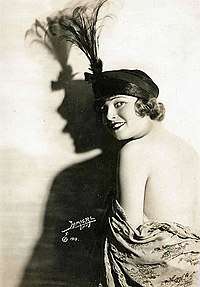
In 1916, she signed a $15-weekly contract with Vitagraph,[25] and took the stage name Corinne Griffith.[30] She made her screen debut in a short film titled La Paloma, opposite Earle Williams.[29] She appeared in a series of short films for the studio before becoming a leading lady.[25] On April 22, 1920, Griffith married her first husband, Webster Campbell, at a private ceremony in Oceanside, California.[31]
Griffith's performance in one of her later films for Vitagraph, The Broadway Bubble (1920), was described by a critic of the Austin American-Statesman as the "strongest and most fascinating role in her notable career" and lauded as her "crowning achievement."[32]
1923–1932: First National contract
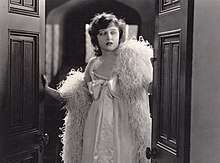
In 1923, after three years of marriage, Griffith divorced Webster, whom she claimed was an abusive alcoholic.[33] The same year, Griffith left Vitagraph Studios, signing a more lucrative contract of $10,000 a week with First National,[25] where she became one of their most popular stars.[34] Her first film for the studio was Frank Lloyd's Black Oxen (1923), a drama in which she portrayed a mysterious Austrian countess. The film, in which Griffith co-starred with Conway Tearle and Clara Bow, became a hit.[35]
Griffith married producer Walter Morosco in February 1924.[31] The same year, she starred in and executive-produced three pictures: Single Wives, Love's Wilderness, and Lilies of the Field.[36] All three of the films were box-office hits.[37] By 1927, Griffith had begun investing her income from making films in real estate, and at that time owned approximately $500,000 worth of properties.[1]
In 1928, she had the starring role in The Garden of Eden for United Artists, which, though critically praised, was not a box-office hit.[38] Disappointed by the film's lackluster dividends, Griffith returned to First National to appear in Frank Lloyd's The Divine Lady (1929), a sound film featuring synchronized music but no audible dialogue.[38] Griffith earned critical accolades for her performance, including a nomination for the Academy Award for Best Actress.[38][39]
Griffith's first full sound film was Lilies of the Field, a remake of the 1924 silent film in which she had previously starred in the same role. Griffith's voice, which was regarded as nasal,[25] did not record well (The New York Times stated that she "talked through her nose"),[3] and the film was a box office flop.[40] The following year, she starred in the drama Back Pay (1930), based on a story by Fannie Hurst, which was promoted as being her final screen appearance.[38] After a two-year hiatus following Back Pay, Griffith starred in the British film Lily Christine (1932),[41] and then left the public eye completely.[38]
1933–1964: Post-film career
After her retirement from film, Griffith divorced husband Morosco in 1934. Two years later, she married businessman and Washington Redskins owner George Preston Marshall. In December 1941, the couple adopted two daughters, Pamela and Cynthia.[42] In the early years of her marriage to Marshall, she composed the lyrics to the Redskins fight song "Hail to the Redskins" which became one of the most famous football anthems.[43]
In the 1940s, Griffith began investing in real estate in the Los Angeles area.[44] She funded the construction of four commercial buildings on all four corners of the intersection of Wilshire Boulevard and South Beverly Drive in Beverly Hills, California.[44] The construction of the buildings, each named after her, proved lucrative, and she turned down an offer of $2.5 million for them in 1950.[11] The same year, she spoke at the inaugural National Association of Real Estate Boards convention in Florida.[44] "I liked the vacant business lots I saw in Beverly Hills with the For Sale signs on them," she recalled. "They were so near the beautiful homes there in that section and I couldn't help but feel that someday the business section would grow up to the great buying power of these wealthy estates."[44]
–Griffith on women's financial autonomy[8]
In addition to her real estate ventures, beginning in the 1950s Griffith became a vocal supporter of repealing the 16th Amendment, which authorized income tax.[25] Over the ensuing decade, she gave approximately 500 speeches on the subject.[45] Commenting on her dedicaton to the topic, she stated: "We have no substitute of other taxes because we have no substitute for waste, graft and corruption. If the federal government will eliminate only part of its waste, just 40 billions of dollars a year of its waste... I can prove to you in dollars and cents that the government does not need the income tax."[46] Griffith also spoke in support of women seeking their own financial autonomy.[8]
In addition to her real estate career, Griffith was also an accomplished writer who published eleven books including two best-sellers, My Life with the Redskins (1947), and the memoir Papa's Delicate Condition (1952), which chronicled her upbringing and family live in Texarkana.[26] Her third publication, 1955's Eggs I Have Known, was a recipe book.[4] In 1958, Griffith divorced Marshall. In 1960, she was honored for her contributions to the motion picture industry with a star on the Hollywood Walk of Fame at 1560 Vine Street. She subsequently published her fourth book, Antiques I Have Known, a non-fiction book about Griffith's interest in antiques.[47] Griffith returned to the screen in 1962 in the low-budget melodrama Paradise Alley, which received scant release, and marked her final film role. Also in 1962, she published two books: Hollywood Stories, a selection of fictional short stories,[26] and Taxation Without Representation—or, Your Money Went That-a-Way, which entailed an argument against income taxation.[46] The following year, her memoir Papa's Delicate Condition was made into a biographical feature film of the same name starring Jackie Gleason.[48]
1965–1979: Claims about identity and final years
In February 1965, she married her fourth husband, Broadway actor Danny Scholl in Alexandria, Virginia.[49] Scholl was 44 years old, more than 25 years Griffith's junior.[49] The couple separated after two months of marriage.[49] Within the year, Griffith filed for a divorce after a judge denied her motion for an annulment, with her contesting that the marriage had not been consummated.[49] Pending trial, she was ordered to pay alimony of $200 per month to Scholl beginning in December 1964.[49]
During their divorce court proceedings in May 1966,[49] Griffith testified that she was actually not Corinne Griffith, instead claiming that she was the actress's younger (by 20 years) sister, who had taken her place upon the famous sister's death in 1924.[50] She also denied having married her former two husbands, Webster Campbell and Walter Morosco.[31] In court, Scholl's attorney proposed that Griffith had falsified her age in the couple's marriage documents as well as failed to disclose her previous two marriages.[31] Upon being questioned about her true age, Griffith refused to comment, stating that her religion, Christian Science, prevented her from publicly disclosing it.[26] She also claimed not to have kept record of her age since she was 13 years old.[31] Contradictory testimony by actresses Betty Blythe and Claire Windsor, who had both known Griffith since the 1920s, did not shake her story, and she continued to claim that she was in fact Corinne's sister.[51][52]
In a subsequent interview, Griffith further complicated her story, claiming to be Corinne's twin named Mary, rather than her younger sister:
I am Mary Griffith. Her twin sister. Let me explain. She, Corinne, was starring in a film in Mexico in 1920. She was stricken by a mysterious local malady and died suddenly at age twenty-four. Mr. Adolph Zukor, head of Paramount, called me in person and told me I must save the day; a cancellation of the picture would be a disaster for the studio. He told me what had happened; I cried and cried. He said I must pull myself together: there was a million dollars in it if I would become my sister. I had never acted and didn't want to act. But I couldn't resist the money, and I felt Corinne would want me to help. So I went to Mexico and took over, and nobody knew the difference. From then on, I was Corinne Griffith.[53]
Additionally, in the same interview, she stated that Corinne had been buried in an unmarked grave in Mexico.[53]
Following the publicity surrounding her divorce and mistaken identity claims, Griffith spent the remainder of her years writing. In 1969, she published Not for Men Only – but Almost, a non-fiction book detailing the appeal of sports to men, and its lack of appeal for most women.[54] She published another collection of personal non-fiction stories titled This You Won't Believe in 1972.[26] Her final book I'm Lucky at Cards (1974) was a book of essays penned by Griffith.[55]
Screen and public image
Griffith was lauded by numerous publications for her beauty. Valeria Beletti, a secretary of Samuel Goldwyn, described Griffith as "the most beautiful of all the silent stars, talented or otherwise," despite the fact that she personally found Griffith abrasive: "very haughty and disdainful. She looks at no one but her dogs, and is generally disliked by all."[26] According to biographer Anthony Slide, the common phrase "the camera loves her" was first coined for Griffith.[26]
In addition to her appearance, Griffith took efforts to maintain a decorous and healthful image, claiming never to have smoked or drank alcohol.[56] She also avoided swearing and refrained from wearing make-up when not appearing on film.[56] Columnist Adela Rogers St. Johns once referred to Griffith as "innocence personified."[56]
Death
Griffith suffered a stroke in early July 1979, brought on by cerebral arteriosclerosis, and was hospitalized at Saint John's Hospital in Santa Monica, California.[57] She died there shortly after of a heart attack on July 13, aged 84.[26] Griffith's sister Augusta, from whom she had been estranged, had died only weeks earlier.[57] Griffith's remains were cremated by the Chapel of the Pines Crematory in Los Angeles, and buried at sea in the Pacific Ocean.[7] At the time of her death, Griffith's estate had amassed $150 million, largely consisting of the properties she owned.[1]
Filmography
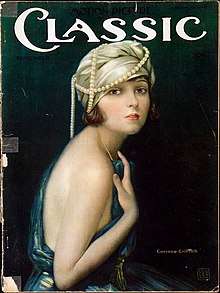
.
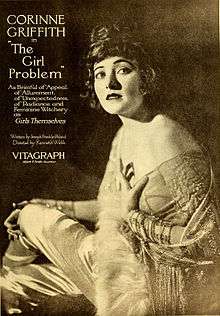
.png)
| Denotes a lost or presumed lost film. |
| Year | Title | Role | Notes | Ref. |
|---|---|---|---|---|
| 1916 | La Paloma |
Stella | Short film | [58] |
| 1916 | Bitter Sweet |
Ruth Slatter – John's Wife | Short film | [59] |
| 1916 | When Hubby Forgot |
The Maid | Short film | [60] |
| 1916 | Sin's Penalty |
Lola Wilson | Short film | [61] |
| 1916 | Miss Adventure |
Gloria | Short film | [62] |
| 1916 | The Cost of High Living | Jack's Sister | Short film | [63] |
| 1916 | The Rich Idler |
Marion- Mary's Friend | Short film | [4] |
| 1916 | Ashes |
The Nurse | Short film | [4] |
| 1916 | The Waters of Lethe |
Joyce Denton | Short film | [4] |
| 1916 | The Yellow Girl | Corinne | Short film | [4] |
| 1916 | A Fool and His Friend |
Short film | [4] | |
| 1916 | Through the Wall |
Pussy Wimott | [59] | |
| 1916 | The Last Man |
Lorna | [59] | |
| 1916 | His Wife's Allowance |
Short film | [64] | |
| 1917 | The Mystery of Lake Lethe |
Short film | [4] | |
| 1917 | The Stolen Treaty |
Irene Mitchell | [59] | |
| 1917 | Transgression |
Marion Hayward | [59] | |
| 1917 | The Love Doctor |
Blanche Hildreth | [59] | |
| 1917 | I Will Repay |
Virginia Rodney | [59] | |
| 1917 | Who Goes There? |
Karen Girard | [59] | |
| 1918 | The Menace |
Virginia Denton | [59] | |
| 1918 | Love Watches |
Jacqueline Cartaret | [59] | |
| 1918 | The Clutch of Circumstance |
Ruth Lawson | [59] | |
| 1918 | The Girl of Today |
Leslie Selden | [59] | |
| 1918 | Miss Ambition |
Marta | [59] | |
| 1919 | The Adventure Shop |
Phyllis Blake | [59] | |
| 1919 | The Girl Problem |
Erminie Foster | [59] | |
| 1919 | The Unknown Quantity |
Mary Boyne | [59] | |
| 1919 | Thin Ice | Alice Winton | [59] | |
| 1919 | A Girl at Bay |
Mary Allen | [59] | |
| 1919 | The Bramble Bush |
Kaly Dial | [59] | |
| 1919 | The Climbers | Blanche Sterling | [59] | |
| 1920 | The Tower of Jewels |
Emily Cottrell | [59] | |
| 1920 | Human Collateral |
Patricia Langdon | [59] | |
| 1920 | Deadline at Eleven |
Helen Stevens | [59] | |
| 1920 | The Garter Girl |
Rosalie Ray | [59] | |
| 1920 | Babs |
Barbara Marvin; "Babs" | [59] | |
| 1920 | The Whisper Market |
Erminie North | [59] | |
| 1920 | The Broadway Bubble |
Adrienne Landreth/Drina Lynn | [59] | |
| 1921 | It Isn't Being Done This Season |
Marcia Ventnor | [59] | |
| 1921 | What's Your Reputation Worth? |
Cara Deene | [59] | |
| 1921 | Moral Fibre |
Marion Wolcott | [59] | |
| 1921 | The Single Track |
Janette Gildersleeve | [59] | |
| 1922 | Received Payment |
Celia Hughes | [59] | |
| 1922 | A Virgin's Sacrifice |
Althea Sherrill | [59] | |
| 1922 | Island Wives |
Elsa Melton | [59] | |
| 1922 | Divorce Coupons |
Linda Catherton | [59] | |
| 1922 | The Common Law |
Valerie West | [59] | |
| 1923 | Black Oxen | Madame Zatianny/Mary Ogden | [59] | |
| 1923 | Six Days | Laline Kingston | [59] | |
| 1924 | Single Wives | Betty Jordan | Executive producer | [59] |
| 1924 | Love's Wilderness | Linda Lou Heath | Executive producer | [59] |
| 1924 | Lilies of the Field |
Mildred Harker | Executive producer | [59] |
| 1925 | Déclassée | Lady Helen Haden | Producer | [59] |
| 1925 | Classified | Babs Comet | Producer | [59] |
| 1925 | Infatuation |
Violet Bancroft | Executive producer | [59] |
| 1925 | The Marriage Whirl |
Marian Hale | Executive producer | [59] |
| 1926 | Mademoiselle Modiste |
Fifi | Executive producer | [59] |
| 1926 | Into Her Kingdom |
Grand Duchess Tatiana (at 12 and 20) | Executive producer | [59] |
| 1926 | Syncopating Sue |
Susan Adams | Executive producer | [59] |
| 1927 | The Lady in Ermine |
Mariana Beltrami | Executive producer | [59] |
| 1927 | Three Hours | Madeline Durkin | Executive producer | [59] |
| 1928 | The Garden of Eden | Toni LeBrun | [59] | |
| 1928 | Outcast | Miriam | [59] | |
| 1929 | Saturday's Children |
Bobby Halevy | [59] | |
| 1929 | Prisoners |
Riza Riga | [59] | |
| 1929 | The Divine Lady | Lady Emma Hart Hamilton | Nominated— Academy Award for Best Actress | [59] |
| 1930 | Lilies of the Field |
Mildred Harker | [59] | |
| 1930 | Back Pay | Hester Bevins | [59] | |
| 1932 | Lily Christine | Lily Christine Summerset | [59] | |
| 1962 | Paradise Alley | Mrs. Wilson | Alternative title: Stars in the Backyard | [59] |
Bibliography
- My Life with the Redskins (1947) – history of the Washington Redskins football team, owned by her husband, George Marshall
- Papa's Delicate Condition (1952) – memoir of her childhood
- Eggs I Have Known (1955) – collection of recipes
- Antiques I Have Known (1961) – book about her interest in antiques
- Taxation Without Representation—or, Your Money Went That-a-Way (1962) – Griffith's argument against taxes
- I Can't Boil Water (1963) – collection of recipes she obtained from famous restaurants
- Hollywood Stories (1963) – collection of short fiction written by Griffith
- Truth Is Stranger (1964) – collection of true stories and anecdotes told by Griffith that struck her as stranger than any fiction
- Not for Men Only – but Almost (1969) – a book on sports and its lack of appeal for most women
- This You Won't Believe (1972) – another collection similar to Truth Is Stranger
- I'm Lucky at Cards (1974) – a book of various essays by Griffith
Notes
- Some sources state Griffith was born November 24,[4] though biographer Anthony Slide[5] as well as the National Museum of American History[6] among others[7] cite November 21 as her birthdate. Sources regarding her birth year erroneously vary from 1896[4] to 1906,[8] though the California Death Index corroborates November 21, 1894 as her birthday.[9] Additionally, U.S. census records from 1900 indicate that a then-six-year-old Corinne Griffin resided in a Waco boardinghouse with her father, J. L. Griffin, mother, A. Griffin, and sister, "Gussie" (Augusta).[10]
- Several sources claim Texarkana as Griffith's birthplace, but her obituary in The New York Times[8] states that she was born in Waco. This is supported by an article from The Washington Post that states Griffith herself asserted that she had been born in Waco, not Texarkana, though she was raised in the latter.[11]
References
- Haile 2019, p. 77.
- Slide 2010, p. 170.
- Porter 2005, p. 301.
- Slater, Tom. "Corinne Griffith". Women Film Pioneers Project. Columbia University. Archived from the original on October 10, 2019.
- Slide 2010, p. 168.
- "Corinne Griffith cinema card". National Museum of American History. Archived from the original on October 10, 2019.
- Wilson 2016, p. 300.
- Goodman, George, Jr. (July 22, 1979). "Corinne Griffith, Silent Movie Star". The New York Times. Archived from the original on March 15, 2018.
- California Death Index, 1940–1997 (November 26, 2014). Corinne Griffith, 13 Jul 1979; Department of Public Health Services, Sacramento. Retrieved October 11, 2019. (subscription required)
- "Corine Griffin in household of Joe Lehman, Waco city Ward 4, McLennan, Texas, United States", United States Census, 1900; Waco, Texas; roll T623, page 18A, line 7, enumeration district 78, Family History film 1,241,656. (subscription required) Archived copy.
- Joyce, Maureen (July 15, 1979). "Corinne Griffith, Film Star, Redskins Adviser, dies". The Washington Post. Archived from the original on October 11, 2019. Retrieved October 11, 2019.
- "Death of Jack Griffin". The Marshall Messenge. Marshall, Texas. March 26, 1912. p. 7 – via Newspapers.com.
- Pylant 2014, pp. 31–35.
- Pylant 2014, pp. 6–14.
- "Griffin-Ghio". Dallas Daily Herald. Dallas, Texas. July 8, 1887. p. 4 – via Newspapers.com.
- Pylant 2014, pp. 13–16.
- Pylant 2014, p. 31.
- Pylant 2014, p. 160.
- Caulfield, Tom (March 7, 1952). "Papa Was a Man to Make Kids' Dreams Come True". The Waco News-Tribune. Waco, Texas. p. 35 – via Newspapers.com.
- Haile 2019, p. 75.
- "Many Film Stars Are Texas 'Exes'". The Kerrville Times. Kerrville, Texas. November 24, 1938. p. 2 – via Newspapers.com.
- Pylant 2014, p. 75.
- Who's Who in America. Marquis-Who's Who. 1954. p. 1427.
- Bodeen 1975, p. 514.
- Richter, Karl (October 4, 2019). "Silent film stardom just the start for Texas side's Griffith". Texarkana Gazette. Texarkana, Texas. Archived from the original on October 5, 2019.
- Slide 2010, p. 169.
- Sanchez 1930, p. 41.
- Bartee 2019, p. 75.
- Griffith, Corinne (February 28, 1919). "Corinne Griffith Thanks Mardi Gras". New York Daily News. New York City, New York. p. 7 – via Newspapers.com.
- "A Talented Texas Girl". Corsicana Semi-Weekly Light. Corsicana, Texas. November 23, 1915. p. 2 – via Newspapers.com.
- "Divorce Puzzler: Will Real Corinne Griffith Please Stand Up?". The Tampa Tribune. Tampa, Florida. United Press International. May 6, 1966. p. 9 – via Newspapers.com.
- "Screen Favorites Booked This Week At Crescent Theater". Austin American-Statesman. Austin, Texas. December 26, 1920. p. 14 – via Newspapers.com.
- Pylant 2014, pp. 115–116.
- Lowe 2004, p. 258.
- Woodward 1999, p. 96.
- Sanchez 1930, p. 411.
- Bodeen 1975, p. 518.
- Bodeen 1975, p. 520.
- "The 2nd Academy Awards (1930) Nominees and Winners". Academy Awards. Academy of Motion Picture Arts and Sciences. Archived from the original on April 2, 2015.
- Barrios 1995, p. 317.
- "Lily Christine (1932)". British Film Institute. Archived from the original on November 14, 2017.
- "Corinne Griffith Assumes Mother Role, Adopting Two". Los Angeles Times. Los Angeles, California. December 20, 1941. p. 23 – via Newspapers.com.
- Richman 2007, p. 15.
- National Association of Realtors Staff (November 2008). "Movie Star Corinne Griffith's 'Romance in Real Estate'". National Association of Realtors. Archived from the original on May 8, 2017.
- "Film Star Leads War on Income Tax". The Philadelphia Inquirer. Philadelphia, Pennsylvania. November 17, 1960. p. 60 – via Newspapers.com.
- Johnson, Erskine (May 13, 1963). "Corinne Griffith Would Eliminate Tax". The Jackson Sun. Jackson, Tennessee. p. 11 – via Newspapers.com.
- Liebman 1996, p. 138.
- "State Line Shows Variety Of Hits During Week". Elizabethton Star. Elizabethton, Tennessee. September 8, 1963. p. 6 – via Newspapers.com.
- "Hubby Loses Alimony Plea, Actress Wins Her Divorce". The Tampa Tribune. Tampa, Florida. United Press International. May 15, 1966. p. 10-A – via Newspapers.com.
- Higham 2004, pp. 131–132.
- Pylant 2014, p. 207.
- Higham 2004, p. 14.
- Higham 2004, p. 132.
- "Sports Bookshelf". The News Journal. Wilmington, Delaware. December 18, 1969. p. 68 – via Newspapers.com.
- Addis 1983, p. 194.
- Haile 2019, p. 76.
- Pylant 2004, p. 222.
- "La Paloma". The Moving Picture World. Vol. 27. March 4, 1916. p. 1530. OCLC 1717051.
- "Corinne Griffith filmography". AFI Catalog of Feature Films. American Film Institute. Archived from the original on October 10, 2019. Retrieved October 10, 2019.
- Pylant 2014, p. 113.
- "Sin's Penalty". The Moving Picture World. Vol. 28. April 15, 1916. p. 497. OCLC 1717051.
- "Miss Adventure". The Moving Picture World. Vol. 28. May 27, 1916. p. 1565. OCLC 1717051.
- "A Week of Vitagraphs". The Moving Picture World. Vol. 28. May 27, 1916. p. 1521. OCLC 1717051.
- "The Penn". The News-Journal. Wilmington, Delaware. December 25, 1916. p. 3 – via Newspapers.com.
Sources
- Addis, Patricia K. (1983). Through a Woman's I: An Annotated Bibliography of American Women's Autobiographical Writings, 1946-1976. Lanham, Maryland: Scarecrow Press. ISBN 978-0-810-81588-9.CS1 maint: ref=harv (link)
- Barrios, Richard (1995). A Song in the Dark: The Birth of the Musical Film. New York City, New York: Oxford University Press US. ISBN 0-19-508811-5.CS1 maint: ref=harv (link)
- Bodeen, DeWitt (1975). "Corinne Griffith: The Orchid of the Silver Screen". Films in Review. National Board of Review of Motion Pictures. 26: 514–528. ISSN 0015-1688.CS1 maint: ref=harv (link)
- Haile, Bartee (2019). Texas Entertainers: Lone Stars in Profile. Chicago, Illinois: Arcadia, Publishing. ISBN 978-1-439-66648-7.CS1 maint: ref=harv (link)
- Higham, Charles (2004). Murder in Hollywood: Solving a Silent Screen Mystery. Madison, Wisconsin: Terrace Books. ISBN 978-0-299-20364-1.CS1 maint: ref=harv (link)
- Liebman, Roy (1996). Silent Film Performers: An Annotated Bibliography of Published, Unpublished and Archival Sources for Over 350 Actors and Actresses. Jefferson, North Carolina: McFarland. ISBN 978-0-786-40100-0.CS1 maint: ref=harv (link)
- Lowe, Denise (2004). An Encyclopedic Dictionary of Women in Early American Films, 1895–1930: 1895–1930. New York City, New York: Routledge. ISBN 0-7890-1843-8.CS1 maint: ref=harv (link)
- Porter, Darwin (2005). Howard Hughes: Hell's Angel. New York City, New York: Blood Moon Productions, Ltd. ISBN 0-9748118-1-5.CS1 maint: ref=harv (link)
- Pylant, James (2014). Texas Gothic: Fame, Crime and Crazy Water. Stephenville, Texas: Jacobus Books. ISBN 978-0-984-18577-1.CS1 maint: ref=harv (link)
- Richman, Michael (2007). The Redskins Encyclopedia. Philadelphia, Pennsylvania: Temple University Press. ISBN 1-59213-542-0.CS1 maint: ref=harv (link)
- Sanchez, Nellie van De Grift (1930). California and Californians. 4. Chicago, Illinois: Lewis Publishing Company. OCLC 123306377.CS1 maint: ref=harv (link)
- Slide, Anthony (2010). Silent Players: A Biographical and Autobiographical Study of 100 Silent Film Actors and Actresses. Lexington, Kentucky: University Press of Kentucky. ISBN 978-0-813-13745-2.CS1 maint: ref=harv (link)
- Wilson, Scott (2016). Resting Places: The Burial Sites of More Than 14,000 Famous Persons (3rd ed.). Jefferson, North Carolina: McFarland. ISBN 978-0-786-47992-4.CS1 maint: ref=harv (link)
- Woodward, Kathleen, ed. (1999). Figuring Age: Women, Bodies, Generations. Bloomington, Indiana: Indiana University Press. ISBN 978-0-253-11384-9.CS1 maint: ref=harv (link)
External links
| Wikimedia Commons has media related to Corinne Griffith. |